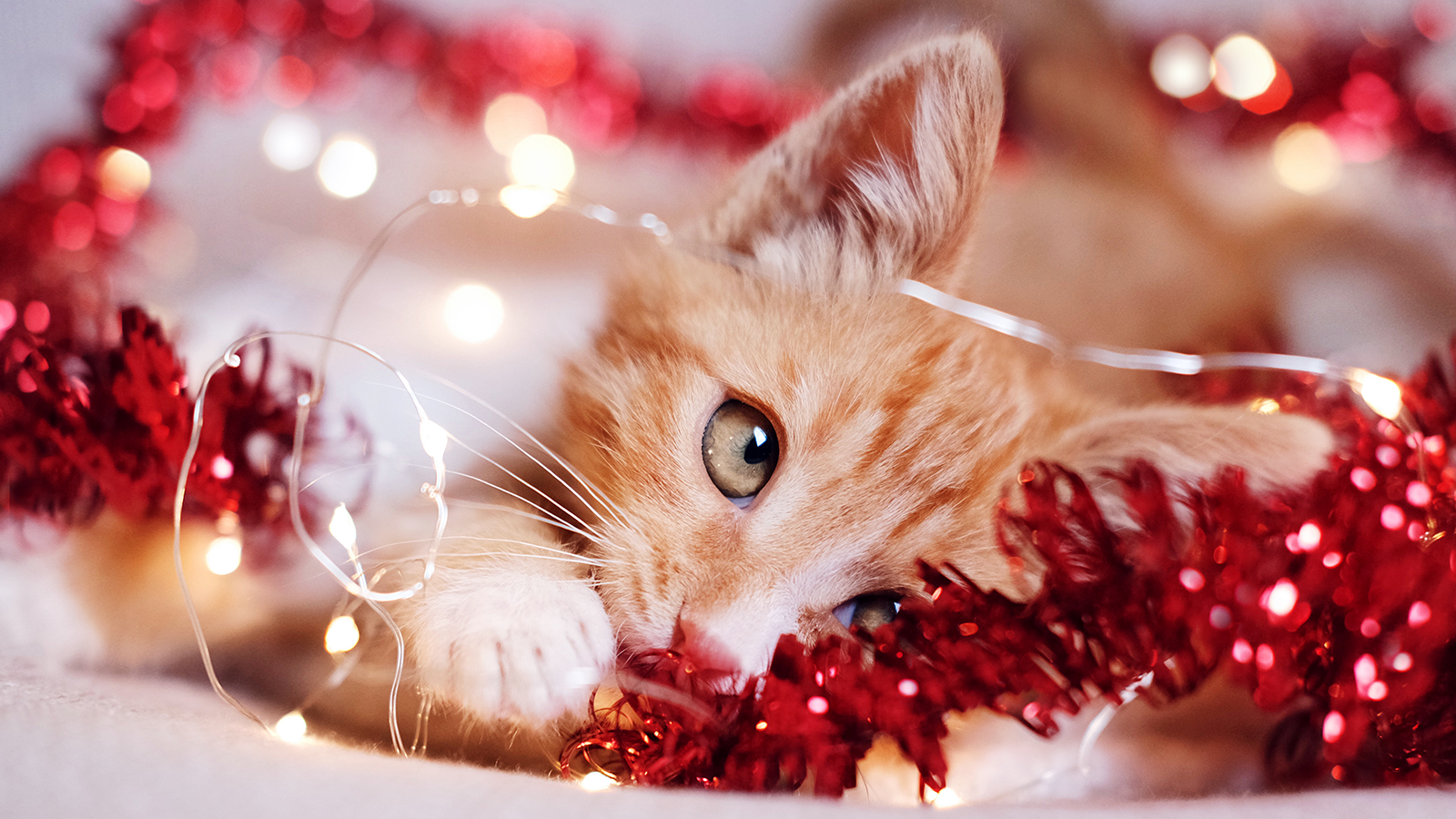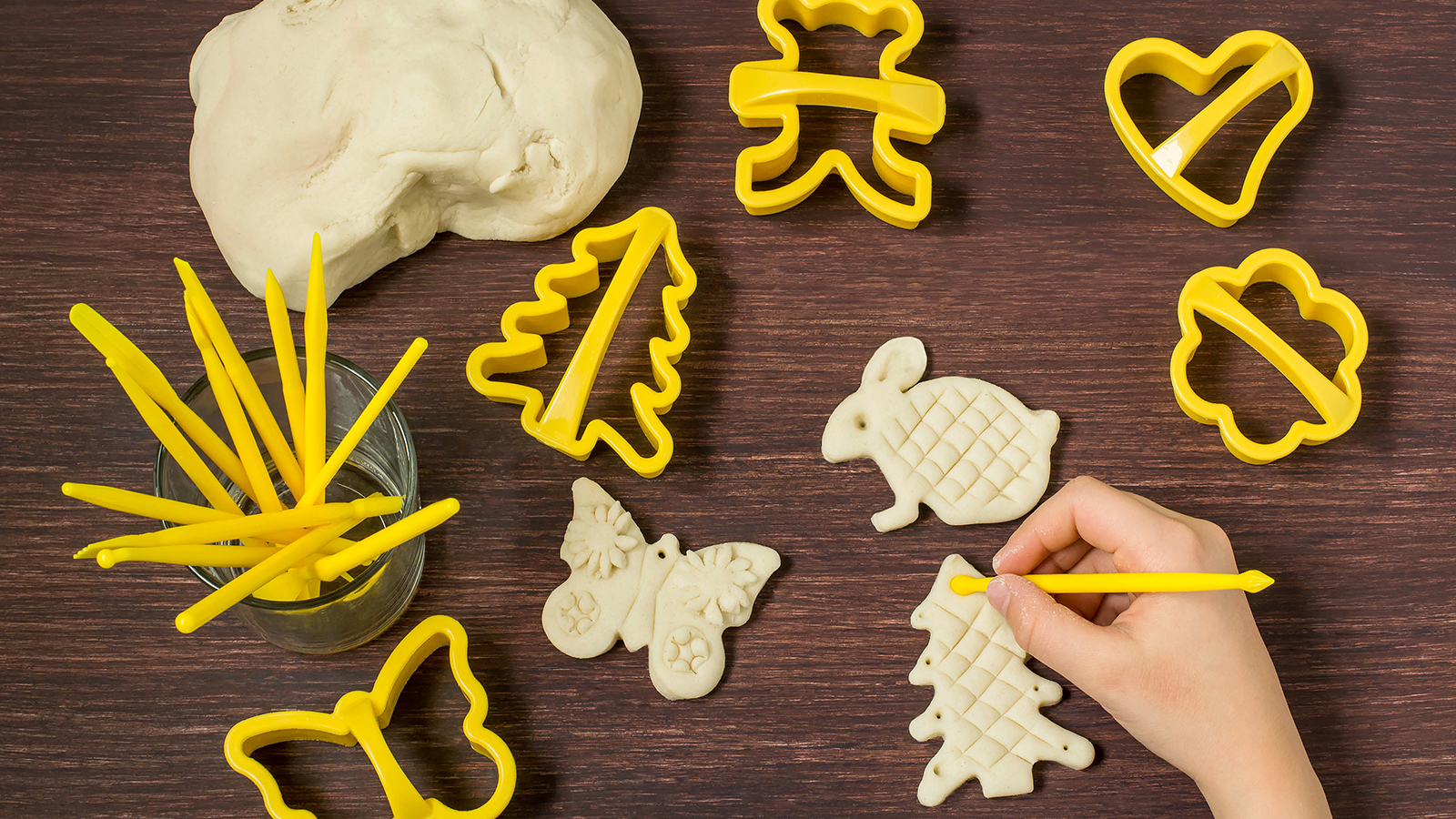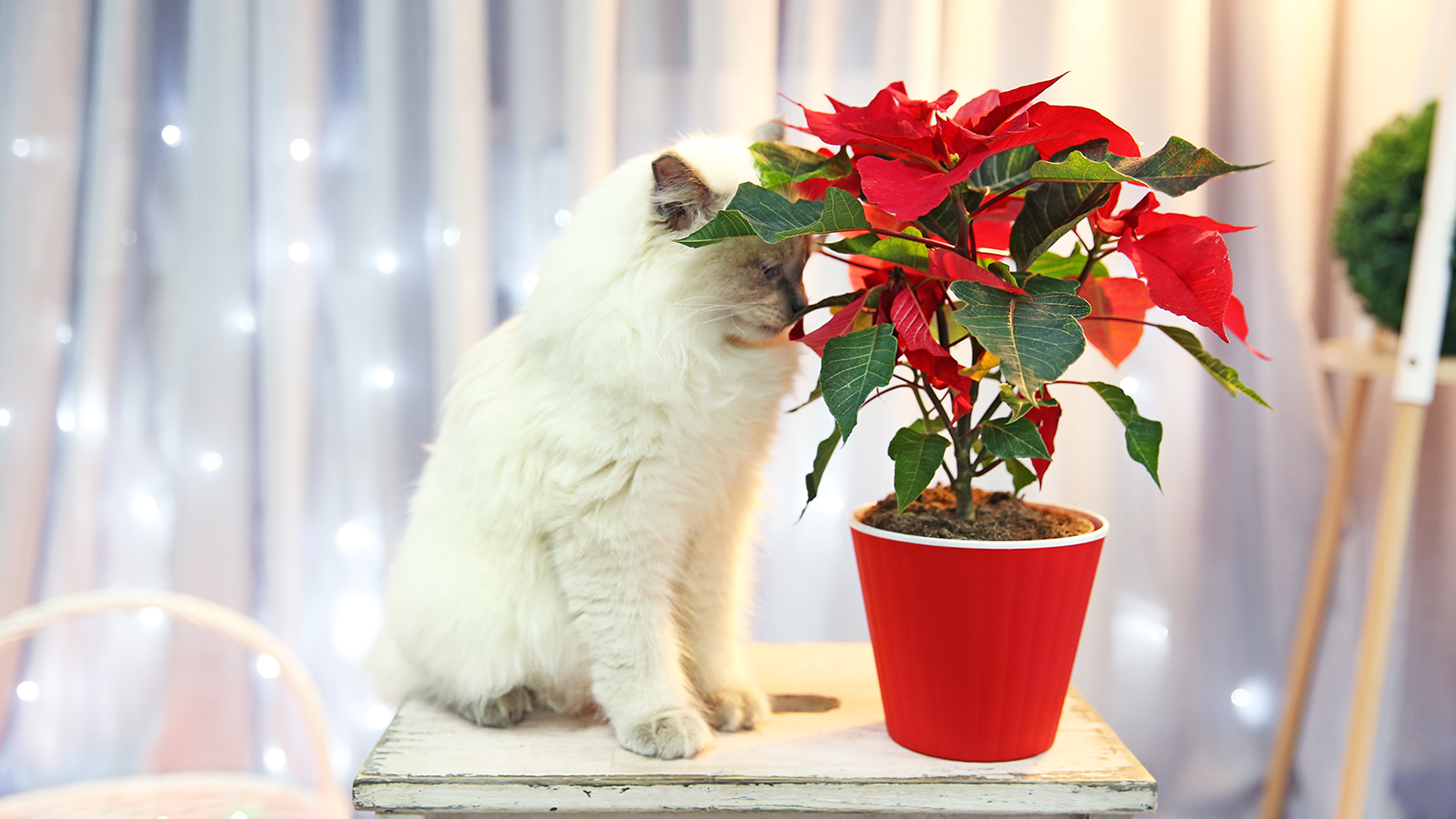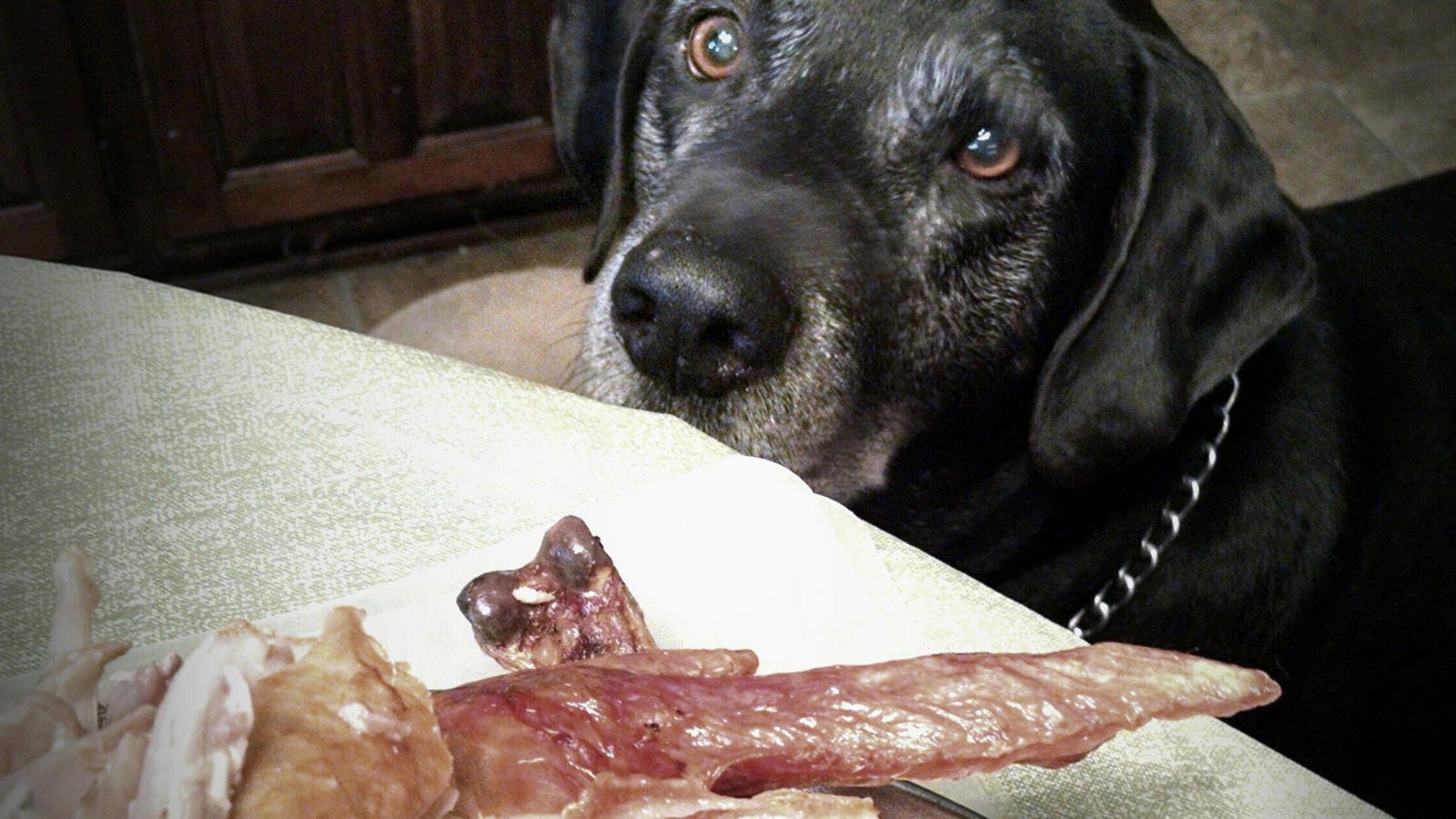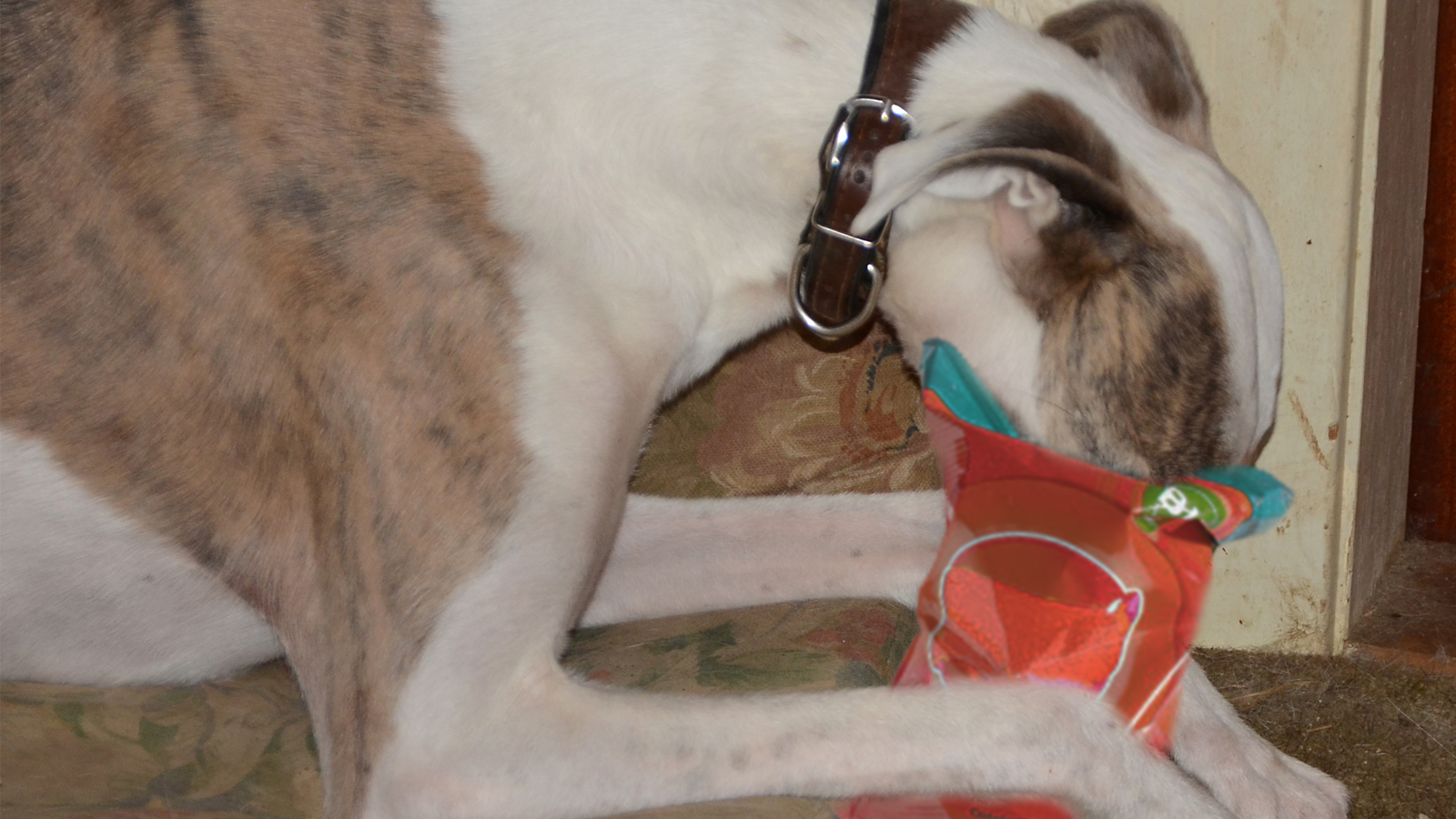Take the "Oh No!" Out of Your and Your Pets' Holiday "Ho-Ho-Ho!"
Yes, it’s that holiday time of year again. While you’re busy decorating, baking, wrapping gifts, and preparing your household for guests, remember to watch out for holiday temptations for your pets. Don’t let a pet disaster turn both your and your pets’ Holiday “Ho-Ho-Ho!” into a Holiday “Oh No!”
Pet Treats
Tinsel and Ribbons
Play Dough and Salt Ornaments
Plants
Table Scraps
People Treats
People Medicines
Cigarette Butts, Vape Pens, and Refill Cartridges
The "Wrap Up"
How Can You Get More Information?
Pet Treats
Santa brought Fido his favorite pet treats as a stocking stuffer. Lucky Fido! But be careful. Because he likes his favorite treats so much, Fido may eat them whole, or eat too many at one time. Pet treats, whether biscuits, rawhides, or jerky sticks, are most digestible when chewed into small pieces. Unchewed pet treats can get stuck in his trachea (windpipe) or gastrointestinal tract (esophagus, stomach, and intestines).
If a piece of pet treat gets stuck in Fido’s trachea (windpipe), you may see him become frantic and start drooling and choking. Severe tracheal blockages are common, especially around the holidays, and all are life-threatening. If you see frantic Fido drooling and choking, he needs an emergency visit to his veterinarian!
If a piece of pet treat gets stuck in Fido’s esophagus (the tube that connects the mouth to the stomach that food travels through), he may gulp, start drooling, or bring up undigested food after eating. Fido will bring up the undigested food because the piece of pet treat blocks his dog food from getting to his stomach and there’s nowhere else for the food to go but back up. This can go on for days if the blockage is not removed.
If something is stuck in Fido’s stomach or intestines, such as a bone or chew toy, the symptoms are different, and you may not notice for several days. He may vomit and have diarrhea, be less active, not want to eat, and have stomach pain. If the blockage stays in Fido’s stomach or intestines for too long, he may become very ill. The worst-case scenario is when a hole develops at the blockage site, causing a life-threatening infection.
In the cases above, Fido needs a visit to his veterinarian as soon as possible. If he’s choking, it’s an emergency. When in doubt, contact your veterinarian for medical advice. Your veterinarian may need to take X-rays, use ultrasound, or perform other tests to see what and where the problem is. Your veterinarian may use an endoscope (a long tube with a built-in camera and grabbing tools) to remove reachable objects from the esophagus and stomach. Fido will likely need surgery to remove blockages in the intestines.
Tinsel and Ribbons
When decorating your tree and wrapping or unwrapping gifts, keep a close eye on where you leave your leftover tinsel, string, and ribbons. Tigger, your big orange and white kitty, may find these decorations irresistible because they look like easy-to-catch, sparkly, and wiggly prey. If Tigger eats these types of decorations, he may end up with serious stomach and intestinal damage. Swallowed ribbons and string can get tangled in the stomach or intestines. If they are not removed, the ribbons and string can cut through the lining of Tigger's stomach or intestines, causing a life-threatening infection. Symptoms may take a few hours or several days to appear and include vomiting, diarrhea, lack of appetite, and decreased activity. If you see Tigger eat any string, tinsel, or ribbon, call your veterinarian and ask for medical advice. Play it safe—keep the tinsel off the tree and collect all ribbons and strings after opening your gifts.
Play Dough and Salt Ornaments
While you are in the kitchen baking another side dish for the family dinner, Tigger and Fido decide to search the Christmas tree for hidden “munchies”. Fido spies the snowman-shaped salt-dough ornament your son made in school, hanging on a lower branch. Tigger sees the blob of homemade play dough your daughter left under the tree. The snowman ornament smells like a treat, so Fido grabs and eats the whole thing. Tigger takes a few nibbles out the play dough blob as he bats it around like a toy mouse.
Although Fido enjoyed his treat and Tigger liked his nibbles, they may be in for a rude surprise. Salt-dough ornaments and homemade play dough can be harmful to pets because they can contain up to a cup of table salt (sodium chloride).
One cup contains 48 teaspoons of table salt. That is a lot of salt![1]. According to the Pet Poison Helpline, a 10 lb. pet can get sick after eating just ½ teaspoon of table salt. It would only take 1 ½ teaspoons of salt to be fatal to your pet. That’s the same amount of salt in 1 ½ batches of chocolate chip cookie dough[2]. It doesn’t take much.
Salt poisoning is also known as water deprivation poisoning. If a healthy pet has a salty snack or drink, but has plenty of fresh water to drink, he can generally flush out the extra salt from his body. When he doesn't have enough water though, too much salt can build up and cause swelling of the brain. Early symptoms of salt poisoning are drooling, vomiting, and diarrhea. Without treatment, the symptoms can progress to include uncoordinated walking, frequent urination, dehydration, increased thirst, fast heart rate, quick breathing, seizures, coma, and death.
Because Fido and Tigger ate their “munchies”, you may have to stop cooking the holiday dinner and take them for an emergency visit to your veterinarian. A rude surprise, indeed! Keep your salt-dough ornaments and homemade play dough far away from your pets, and make sure they always have access to plenty of fresh water.
Plants
Many people have festive plants around the house for the holidays, including poinsettias, holly, and mistletoe. Remember to keep your furry family members in mind when you display or dispose of your holiday plants.
Poinsettias
Colorful red and white poinsettias fill your living and family rooms, bringing your family holiday cheer. However, Tigger sees the poinsettias and considers them a great hiding place and a convenient snack when you’re late with his dinner.
Unfortunately, what Tigger doesn’t realize is that poinsettias have a milky white, latex sap that can be very irritating to his mouth and stomach. According to the ASPCA Animal Poison Control Center (APCC), symptoms of poinsettia toxicity include drooling, and sometimes, vomiting and diarrhea. Fortunately for Tigger, the symptoms associated with poinsettia toxicity are not too bad.[3] However, if Tigger snacks on your poinsettia leaves, you can help him by picking up his food and water dishes for a couple of hours to let his stomach settle.[4]
Mistletoe
Waiting for a kiss from that special someone under the mistletoe? Tigger or Fido may also be waiting under the mistletoe in hopes of getting a tasty snack. Your horse Trigger may also get a mistletoe snack if you hang it near her stall door or throw it into her field after the holiday celebrations are over. If your pets eat mistletoe, what should you expect? The APCC states that the major toxic chemicals in mistletoe are lectins and phoratoxins. These chemicals affect the heart, causing low blood pressure and slowed heart rate. Fortunately for Fido, Tigger, and Trigger, severe mistletoe toxicity is uncommon and usually only occurs if your pet eats a large amount. The symptoms of mistletoe toxicity include gastrointestinal upset (vomiting and diarrhea in dogs and cats; colic in horses), difficulty breathing, weakness (due to low blood pressure or slowed heart rate), and odd behavior.
Holly
The beautiful holly decorating your house isn’t very harmful, but you should still keep Fido, Tigger, and Trigger from eating the berries and leaves. The main toxic culprit in holly leaves and berries is a group of chemicals called saponins. In dogs and cats, these chemicals cause drooling, vomiting, diarrhea, loss of appetite, and decreased activity.[5] In horses, they can cause diarrhea.[6]
If you suspect Fido, Trigger, or Trigger ate one of the three plants above, it’s a good idea to call your veterinarian. Your veterinarian can give you advice on what you can do at home to make your pet more comfortable and help you decide if your pet needs medical treatment.
Table Scraps
It’s hard to ignore Fido’s sad puppy-dog eyes when you’re eating your holiday meals. However, resist the temptation to give him a piece of turkey or chicken, or some other type of fatty holiday comfort food. In addition to the typical gastrointestinal upset (vomiting and diarrhea), rich and fatty foods can cause a potentially life-threatening and painful disease called pancreatitis. The most common symptoms of pancreatitis in dogs include vomiting, stomach pain, restlessness, shaking, diarrhea, and weakness. In cats, the symptoms are less clear and harder to notice, such as decreased appetite and weight loss.[7] Keep Fido and Tigger happy and healthy by resisting the temptation to give them table scraps!
You’ve done a great job, and neither Fido nor Tigger received any table scraps during your holiday meals. However, disappointed Fido took the opportunity to help himself to the turkey, chicken, and steak bones in the trash. Eating bones can be dangerous to Fido, just like unchewed pet treats. Bones can get stuck in his esophagus, leading to gagging, or they can get stuck in his trachea, leading to life-threatening choking. Also, while Fido chews them up, the bones break into sharp pieces which can injure his mouth, esophagus, and stomach. As the sharp bone pieces travel from the stomach through the intestines, they can cause punctures and injuries along the way, potentially leading to a life-threatening infection. Bone pieces can also get stuck in the stomach and intestines, creating blockages that must be removed.
Hold your ground at dinnertime and resist the urge to feed Fido and Tigger table scraps. Don’t forget, once dinner is done, dispose of the leftovers and bones somewhere Fido and Tigger can’t get to them.
People Treats
Fido, being the big dog he is, decides that eating the bones and leftovers from the trash can isn’t enough for his holiday dinner. So, he table surfs in the living room and eats some of the chocolate-covered caramels in the candy dish along with several sugar-free red and white mints. Can the chocolate and mints hurt him? It depends. Chocolate toxicity depends on the type and amount of chocolate Fido ate, his body weight, and if he’s extra-sensitive to the toxic compound in chocolate called theobromine. Theobromine toxicity can cause a variety of symptoms, from mild to severe, including vomiting, diarrhea, restlessness, hyperactivity, increased urination, muscle spasms, and seizures.[8]
The seemingly harmless sugar-free red and white mints you bought for your diabetic Uncle Ralph can cause life-threatening problems for Fido if the mints contain xylitol. Xylitol, a popular sugar alcohol sweetener, is found in food items such as candy, nut butters, gum, "skinny" ice cream, and baked goods. It can also be found in personal hygiene products, like toothpaste and mouthwash, dietary supplements like gummy vitamins, and prescription and over-the-counter medications.[9] Symptoms of xylitol toxicity can occur in as little as 20 minutes. Vomiting is generally the first symptom, followed by symptoms of low blood sugar (hypoglycemia), like decreased activity, weakness, staggering, incoordination, collapse, and seizures. Some dogs develop more severe complications, including liver failure and bleeding disorders which can be fatal.[10] If you suspect Fido has eaten chocolate or xylitol-containing items, consider it an emergency and call your veterinarian immediately.
Alcohol is another potentially harmful human treat. Fido and Tigger decide they need some holiday cheer and drink the entire glass of eggnog that Aunt Susie left unattended on the coffee table. Although it may seem funny at the time, pets that consume alcohol can develop serious problems depending on how much they drink. The most common symptoms are vomiting, diarrhea, incoordination, weakness, decreased activity, difficulty breathing, and shaking. In severe cases, coma and death from respiratory failure (when the lungs stop working) can occur. If you see Fido and Tigger drinking an alcoholic beverage, call your veterinarian.
Fido and Tigger continue their search throughout the house for tempting treats. As they circle back to the kitchen, Fido finds an empty potato chip bag on the floor that you forgot to toss into the trash. He can smell the yummy potato chip goodness, so he pokes his head inside the bag to eat whatever chips are left. Suddenly, the bag closes around his face and he can’t get out. He paws at the bag, with no success. You happen to walk by, see him struggling, and you pull the bag off his face. Lucky Fido!
Food bags, especially the mylar-type potato chip, cereal, and snack bags, can be dangerous for pets. Dogs are more likely than cats to sniff out food bags. These bags are thin enough that if your dog puts his head far enough into one and breathes in, the bag can wrap around his nose and mouth, suffocating him. The more your dog breathes in, the tighter the bag gets around his face. He can’t easily pull the bag off with his paws because it’s tightly stuck to his face, like shrink wrap. Fido was lucky you happened to walk by to pull off the bag.
People Medicines
In all the chaos of getting ready for the holidays, it’s easy to overlook your holiday guests’ stash of medicines on the kitchen counter, including little cousin Mikey’s fruity-flavored gummy vitamins, allergy medicine, and anti-seizure medicine. Fido and Tigger, however, have noticed these flavored medicines, much to your dismay. You wisely decide to put all the guests’ medicines and vitamins in the medicine cabinet in the bathroom, to keep them out of reach of the children and your furry family members. Some medicines for people, especially those in liquid or gummy form, may contain xylitol as a sweetener so kids, like cousin Mikey, are more likely to take them. Unfortunately, they can pose a danger to pets.
Cigarette Butts, Vape Pens, and Refill Cartridges
While you love your Uncle Ralph, you don’t love his smoking habit. Uncle Ralph sneaks outside to smoke (because you wisely don’t allow smoking in your house) and he drops his cigarette butts in your beautifully landscaped yard.
After the potato chip bag scare, you put Fido outside to keep him out of trouble for a little while. Unfortunately, Fido finds a few of Uncle Ralph’s cigarette butts in the yard and eats them. While cigarette butts may seem like harmless trash, they’re anything but (no pun intended). Cigarette butts can be toxic because they contain concentrated amounts of nicotine.[11] One cigarette butt typically has 5 to 7 mg of nicotine. It only takes 0.5 to 1.0 mg of nicotine per pound of body weight to cause problems in dogs.[12] The toxic dose of nicotine for your neighbor’s 7 lb yappy Yorkie, Snookums, would be between 3.5-7 mg of nicotine. One cigarette butt would be enough to make Snookums sick from nicotine poisoning. Symptoms of nicotine poisoning can range from excitement, shaking, drooling, vomiting, and diarrhea (nicotine makes dogs sick to their stomachs) at low doses to seizures, decreased activity, slowed breathing, slowed heart rate, and even death at high doses.[13], [14] Since you don’t know how many cigarette butts Fido ate, it’s time to call your veterinarian (again). Smoking can be as bad for Fido as it is for Uncle Ralph!
Uncle Ralph is doing his best to quit smoking, however. He has switched to vaping to get his quick hit of nicotine and keep him from lighting up. While this is good for Uncle Ralph and for you (because you won’t have to worry about more cigarette butts in the yard), Uncle Ralph and you still have to be careful. To pets, particularly dogs, vape pens can look like fun chew toys.[15] Vape pens have cartridges filled with a liquid containing concentrated nicotine and flavoring agents.[16] Chewing on a vape pen can give a pet an instant dose of nicotine. As we discussed earlier, nicotine can be harmful or deadly if a pet eats too much. Pre-filled replacement cartridges and refill liquid are also dangerous as they contain concentrated nicotine. To keep Fido and Tigger safe, remind Uncle Ralph to keep his vape pen, cartridges, and refill liquid out of their reach.
The “Wrap Up”
Don’t let the information in this article scare you into paranoia about your pets and your holiday celebrations. You can relax and enjoy your holidays simply by preventing temptations for your pets. Keep holiday decorations, people food, alcoholic beverages, and holiday plants out of reach of your furry friends. If your pets get into things they shouldn’t, don’t panic! Call your veterinarian immediately for advice instead of waiting for serious symptoms to develop. Remember, only you can keep the “Oh no!” out of your and your pets’ Holiday “Ho-Ho-Ho!”
How Can You Get More Information?
- Talk to your pet’s veterinarian
- Visit the Animal Poison Control Center website at http://www.aspca.org/pet-care/animal-poison-control
- Visit the Pet Poison Helpline website at https://www.petpoisonhelpline.com/
- Visit the American Veterinary Medical Association (AVMA) website at https://www.avma.org/public/pages/default.aspx
[1] https://www.inchcalculator.com/convert/cup-salt-to-teaspoon-salt/ accessed 10/13/20.
Aqua-calc: http://www.aqua-calc.com/calculate/food-volume-to-weight/substance/salt-coma-and-blank-table
[2] https://www.verybestbaking.com/toll-house/recipes/original-nestle-toll-house-milk-chocolate-chip-cookies/ accessed 10/13/20.
[3] Volmer P. Toxicology Brief: "How Dangerous are Winter and Spring Holiday Plants to Pets?” Veterinary Medicine. December 2002, pp. 879-884.
[4] Ibid.
[5] Ibid.
[6] https://www.aspca.org/pet-care/animal-poison-control/toxic-and-non-toxic-plants/mistletoe-american
[7] Johnson SE. “Chapter 10: Diseases and Surgery of the Exocrine Pancreas” in Saunders Manual of Small Animal Practice, SJ Birchard and RG Sherding, eds. 1994. WBSaunders Company: Philadelphia, pp. 768-773.
[8] https://vet.purdue.edu/vth/sapc/toxicity-tips.php#1
[9] Dunayer, EK. New Findings on the Effects of Xylitol Ingestion in Dogs. Veterinary Medicine. December 2006, pp. 791-797.
[10] Ibid.
[11] Novotny TE, Hardin SN, Hovda LR, et al. Tobacco and cigarette butt consumption in humans and animals. Tobacco Control 2011;20: 117-120.
[12] https://vetmeds.org/pet-poison-control-list/nicotine-tobacco/ accessed 10/19/22.
[13] https://www.petmd.com/dog/poisoning/tobacco-nicotine-poisoning-dogs accessed 10/19/22.
[14] Ibid.
[15] https://www.petpoisonhelpline.com/uncategorized/toxicity-of-electronic-cigarettes-in-companion-animals/ accessed 9/20/22.
[16] Ibid.


